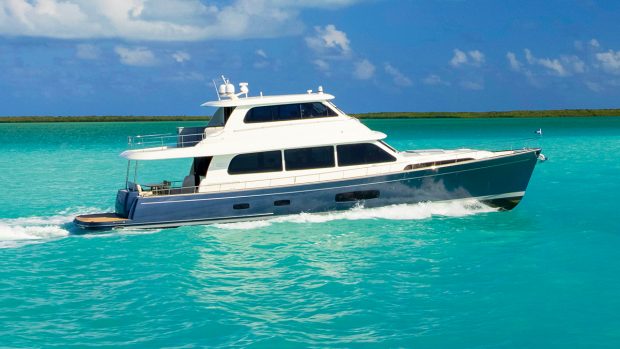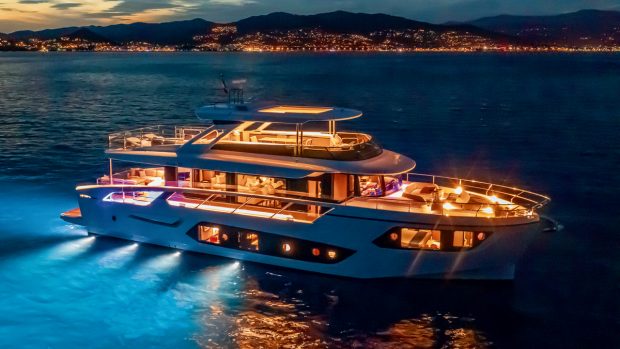With its unique combination of art and design, of engineering and aesthetics, synonymous with the Italian shipyard Riva, the 56 Rivale provides a boating experience like no other
There are few more arresting sights on the water than a Riva barrelling along in the sunshine without a care in the world, like a starlet on a scooter at her first film festival.
Riva’s designers in recent years have been carefully revisiting the look of the company’s old mahogany runabouts, some of which were pretty small – they started at just 13ft and topped out at 28ft. The designers’ aim is to recapture that innocent fun and somehow translate it into the size and heft of a luxury motor yacht without simply creating an oversized retro pastiche.
It’s a combination of art and science, this endeavour to create a boat which is also a floating sculpture. And they have been conspicuously successful.
The Rivamare of 2016, for all its Duoprop and standing headroom, was alive with the spirit of the Aquarama, while their latest essay in this stylistic sleight of hand is the alluring creature that just stopped you in your tracks – the brand new Rivale.
From a distance, the language of its look is entirely intelligible – the proportions, the gentle curves, the deceptive simplicity – and even up close it still looks the part. At 56ft and 30 tonnes, it’s of a size where rival shipyards are quite happy to make their products look big and bulky because it underlines how much bang you’re getting for your buck. Ironically, perhaps – because it’s probably impossible to spend more bucks on a boat of this size – the Rivale still manages to look like a big runabout.
All such impressions are dispelled, however, as soon as you step aboard. Offered with two cabins and three heads in standard form, with shaft-drives, a discreet radar mast and no hardtop, optional or otherwise, to spoil a perfect profile, the Rivale boasts that jewel-like finish for which Rivas are justly famed.
The boat positively glittered in the warm French sunshine at the latest Cannes show.
After admiring the seismically expensive metallic paint job, it was no surprise to find that its owner had also opted for the high-gloss mahogany down below, which didn’t so much contrast with the leather upholstery and pale deckhead linings as add to the quality of the light.
Smoke and mirrors

The midships suite for the owner spans the full beam of the hull, although with the head and shower compartment taking up the port side, the full effect of its spaciousness has to be more imagined than real. Headroom is a reasonable 6ft 5in (1.95m), a figure which is actually bettered by at least an inch everywhere else on the lower deck. If the berth were any longer than its 6ft 3in (1.90m), it would further encroach on the floor area, although big hull windows do an excellent job of selling the idea of size and space. And the heads compartment is great – big, bright and comfortable.
Up in the bow, the VIP suite boasts a slightly longer berth than the master, though it’s slightly narrower, and it sits in a well-planned space with a good heads compartment on the starboard side. Both cabins are reasonably well provided with stowage space, although the VIP, with its rows of eye-level lockers around the cabin sides in addition to a bigger wardrobe and the large under-berth drawer, gets the best of it.
The lower saloon at the bottom of the main companionway is a welcoming spot. Its L-shaped sofa sits beneath a window and a big, cunningly positioned mirror on the forward bulkhead, which seems to double the area’s size. Across on the port side, the galley is a simple affair typical of high-end Italian craft such as this, which are perhaps more likely to be used as dayboats than as serious cruisers, or even weekenders. Owners whose culinary ambitions are satisfied with a correctly chilled wine for a lunchtime salad and the telephone number of the best restaurant in port don’t need a lot of kitchen equipment. There is also a day heads down here, over on the port side – something of an extravagance, perhaps, on an open two-cabin boat.
In fact, our test Rivale had a third cabin, on the port side. It is an option. Glance through the doorway at its minimal floor space and two bunk berths just 23in wide (58cm) and you might surmise that it was converted from a large and potentially useful storage locker, before concluding that perhaps it ought to be converted back again.
In the Rivale’s standard layout, this is where you would find the crew cabin, complete with toilet, which has no door but an overhead access hatch instead, concealed within the cockpit cushions. Unless you plan to actually employ live-in crew, the sensible choice might be to opt for the third cabin and use it for storage.
Upstairs, a bimini on an intricately hinged stainless-steel frame provides shade for your intrepid guests. A similar construction can be specified, as an extra, for the forward sunpad. Cockpit furnishings are simple and classic sofas down the port side, a sideboard to starboard, a sunbed over the tender garage, and a single-seat helm station forward.
Sheer exhilaration

Our Rivale had the larger of the two engine options installed, twin MAN 1200s, driving conventional shafts via V-drive transmissions. No matter how cleverly designed or however wide its sunroof opens, a hardtop can never compete with a true open boat for the sheer exhilaration of the drive. It’s something to do with the limitless sky, uninterrupted views of the sea – and yes, of course, the wind in your hair.
There wasn’t a lot of actual wind on the day, so we were lucky to be able to make our own. On the sort of calm, sun-dappled seas that Rivas were designed for, and against the matchless backdrop of the Côte d’Azur, the Rivale picked up her skirts and soared to a top speed which we measured at a whisker over 37 knots.
Deadrise is a modest 17.8º right aft, which carries well forward providing plenty of lift. This helps to explain not only the impressive acceleration but also the Rivale’s ability to maintain its speed in tight turns, adding to the fun of the driving experience. The other side of that coin, of course, is a fairly firm ride in head seas. We found that the hull would plane comfortably at speeds as low as 20 knots, without any need for trim adjustment, so you’ll still be able to make reasonable progress when throttled back to cope with choppy conditions.
The trim system fitted – it operates through a pair of ‘interceptors’ at the transom rather than conventional tabs – has a four-button control pad on the dash that is brilliantly intuitive once you get used to it, but auto mode proved more than adequate. Once engaged, we were free to enjoy the nimble handling, and eager throttle response without a care in the world.
It’s not strictly true that the Rivale has no rivals. Okay, few yards build boats like this any more and whatever they might say, none has to bear the weighty responsibility, of creating floating works of art. But valid comparisons can be made, and given the astonishing price of this boat, they certainly will. Yet with its unique combination of art and design, of engineering and aesthetics, the Rivale provides a boating experience like no other. 
Contact Ventura Yachts here.

Riva Iseo: A new baby from Riva
Riva to launch the new entry-level Iseo this summer

Riva Ariston 25
First glimpse of a classic revamped for the 21st Century
Riva Aquarama Lamborghini









